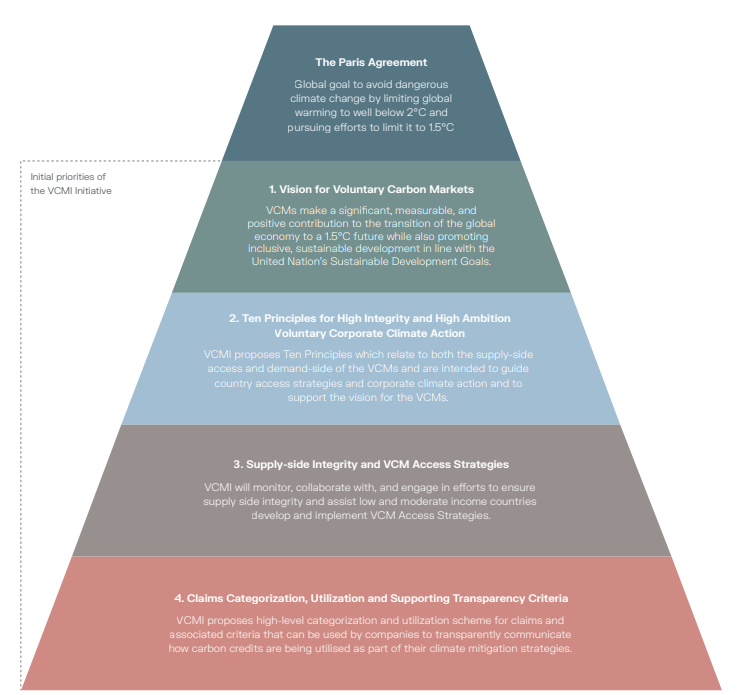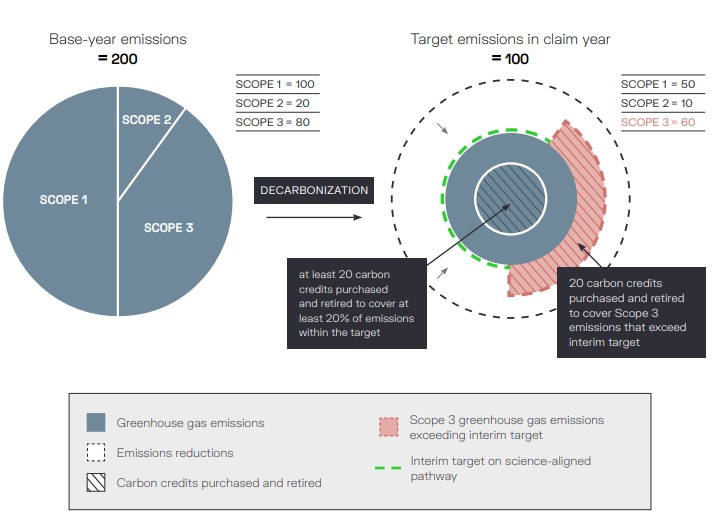This article was co-authored with Edward McCombe.
7 June 2022 saw a major development for voluntary carbon markets (VCMs) globally, with the Voluntary Carbon Markets Integrity Initiative (VCMI) releasing its Provisional Claims Code of Practice (the Code of Practice) for public consultation and corporate road testing.1 The release of the Code of Practice starts a formal public consultation period, with VCMI seeking public input until 12 August 2022. This public consultation phase follows a targeted technical feedback period during which VCMI sought comments from carbon market industry experts from across the globe.
In this article, we provide a snapshot of VCMI’s journey to date, what the Code of Practice contains and what it means for your businesses and industries. If the Code of Practice obtains widespread adoption, it should provide a blueprint for how companies can best protect themselves against “greenwashing” claims.
VCMI’s Road to the Code of Practice
VCMI, which commenced operations in March 2021, is a “multi-stakeholder platform” that aims to “ensure that [VCMs] make a significant, measurable, and positive contribution to the transition of the global economy to a 1.5°C future”.2 VCMI also simultaneously seeks to promote “inclusive, sustainable development” in accordance with the United Nation’s Sustainable Development Goals.3
Since its inception, VCMI has undertaken extensive and wide ranging consultation with governments, private industry, Indigenous Peoples and other key stakeholders to determine key integrity issues and challenges facing VCMs worldwide. This consultation informed the preparation of VCMI’s Global Consultation Report, released in July 2021, and subsequently its Roadmap: Ensuring High Integrity Voluntary Carbon Markets publication, which was released in October 2021. Both of these publications were aimed at establishing and refining an international framework for ensuring carbon market integrity internationally by identifying and addressing key challenges, including those involved in maintaining:
- high integrity supply of carbon credits;
- transparent accounting of emissions reductions; and
- high integrity demand for credible climate commitments.4
Figure 1: Proposed Role of the VCMI in Supporting Global Efforts to Achieve the Paris Agreement

The VCMI Code of Practice
The Code of Practice is primarily designed to provide “clear guidance” for companies and non-state actors on the ways in which they can “credibly make voluntary use of carbon credits as part of their net zero strategy” and “ensure the credibility” of their claims.5
However, the Code of Practice is also intended to be used by:
- individual and institutional consumers seeking to make climate-friendly purchasing decisions;
- investors and other stakeholders who want to judge the integrity and relative ambition of a company commitment and/or goal achievement that includes carbon credits as part of its broader decarbonisation efforts;
- governments considering the role of regulatory agencies in strengthening the credibility of carbon credit use and associated claims by companies through corporate reporting requirements, advertising, and consumer protection standards and other regulations.6
Importantly, the Code of Practice explicitly builds upon other frameworks for carbon market regulation, including the Science Based Target initiative’s (SBTi) Net Zero Standard, The Oxford Principles for Net Zero Aligned Carbon Offsetting and the Carbon Pricing Leadership Coalition’s (CPLC) Report of the Task Force on Net Zero Goals. Drawing upon these existing frameworks, VCMI has stated that the Code of Practice follows several key design principles:
- Carbon credit use must be additional to policy and corporate decarbonisation;
- Companies should follow the accepted “mitigation hierarchy” (a concept central to the SBTi’s Net-Zero Standard that expects companies to set emissions reduction targets within their value chains as a first order priority ahead of actions or investments to offset emissions);
- Reward achievements not just commitments; and
- Incentivise continuous improvement.
Making VCMI Claims under the Code of Practice
At the core of the Code of Practice is a framework through which claims about the use of carbon offsets can be credibly made by companies in compliance with the Code’s requirements. The Code seeks to achieve this objective by establishing a “schedule of claims” which aims to ensure that claims:
- are true and accurate;
- are clear and relevant to their target audience;
- are substantiated with objective, transparent, and up-to-date data;
- avoid overstating the beneficial environmental impacts of the activities on which the claim is based;
- avoid creating a false impression or hiding trade-offs; and
- refer to voluntary actions or achievements that go beyond complying with existing legislation or standard business practice.7
The Code also seeks to provide clear differentiation between levels of accomplishment, so that companies are incentivised to strive towards increasingly significant and substantial climate action.8
The Code of Practice’s structure is broken down into four components, each of which must be adhered to by companies seeking to make credible claims under the Code:
- Compliance with the Code of Practice’s prerequisites for VCMI Claims;
- Identification of the appropriate claims to make;
- Purchasing of high-quality credits; and
- Transparent reporting on the use of carbon credits.
Prerequisites for VCMI Claims Involving Use of High-Quality Carbon Credits
The Code of Practice establishes key threshold requirements that companies must satisfy before they can make a valid VCMI Claim, being that:
- Companies make a public commitment “to achieve science-aligned long term net zero emissions no later than 2050” addressing scope 1, 2 and 3 emissions;
- Companies must set and make public interim emission targets that:
- include a first near-term emission reduction target for 2025, or within two years of making a public long-term net zero commitment;
- include subsequent emissions reduction target(s) with target dates no more than five years apart, established by the date of the preceding target;
- follow SBTi guidance for setting target boundary and emissions coverage (this means 95 percent coverage of Scope 1 and 2 emissions, and 67 percent coverage of Scope 3 emissions if Scope 3 emissions represent over 40 percent of the inventory from all scopes).
- Companies must provide “detailed information on the plans and strategies adopted to achieve their targets”;
- Companies must maintain a “publicly available greenhouse gas emissions inventory” addressing scope 1, 2 and 3 emissions which is in accordance with the Greenhouse Gas Protocol (or equivalent); and
- Companies must make “a public statement declaring that the company’s advocacy activities— either individually or through trade bodies of which it is a member—are consistent with the goals of the Paris Agreement and do not represent a barrier to ambitious climate regulation”.9
VCMI Claims and the Use of Carbon Credits
Claims under the Code of Practice are divided into two main categories:
- Enterprise-Wide Claims – representing “achievement at the enterprise level as companies progress toward their long-term net zero commitment”; and
- Brand-, Product-, and Service-Level Claims – representing “achievement across the full value chain of a specific brand (line of products or services), product, or services”.10
In order to make an Enterprise-Wide Claim, a company must fulfil the further requirements in addition to the above-mentioned pre-requisites:
- reduce its Scope 1 and 2 emissions to the levels required to meets its next interim target;
- reduce its Scope 3 emissions to the level required to meet its next interim target or use carbon credits to cover a limited amount of Scope 3 emissions that exceed the level required to meet its next interim target (note: this flexibility for Scope 3 emissions is only permitted for the “VCMI Bronze” claim [see below] and only available until 2030); and
- Purchase and retire carbon credits to cover some or all of its remaining unabated emissions.11
In the context of Enterprise-Wide Claims, companies can make claims that will fit into one of three levels, ‘Gold’, ‘Silver’ or ‘Bronze’. Importantly, interim targets at all levels must be verified by a “credible, independent third party”.12
- Gold – A company must be “on track to achieve the next interim target for its Scope 1, 2, and 3 emissions” and have “covered all (100 percent) remaining unabated emissions through the purchase and retirement of high-quality carbon credits”.13
Figure 2: Example – Achieving VCMI Gold

- Silver – A company must be:
- on track “to achieve its next interim target for Scope 1, 2 and 3 emissions within its value chain”; and
- have covered “at least 20 percent of all remaining unabated emissions through the purchase and retirement of high-quality carbon credits”.14
Figure 3: Example – Achieving VCMI Silver

- Bronze – A company must:
- be “on track to achieve its next interim target for Scope 1 and 2 through emissions reductions within its value chain”;
- reduce its “Scope 3 emissions through a combination of emissions reductions within its value chain and purchase and retirement of carbon credits (up to a maximum of 50 percent of its Scope 3 footprint) to the level required for its interim target”; and
- have “covered at least 20 percent of all remaining unabated emissions through the purchase and retirement of high-quality carbon credits”.15
Figure 4 : Example – Achieving VCMI Bronze

As noted above, Brand-, Product- & Service-Level Claims are those involving the value chains of specific brands, products or services. The Code of Practice provides the following key requirements for valid VCMI Brand-, Product- Service Level Claims:
- Meet all prerequisites outlined in Step 1 [in section above] for the company as a whole;
- Maintain a publicly available inventory, covering all Scope 1, 2 and 3 lifecycle emissions associated with the division, brand, product, or service, following the GHG Protocol (or equivalent);
- Demonstrate ongoing reductions in the lifecycle emissions and/or emissions intensity associated with the division, brand, product, or service and follow carbon neutrality guidance from a reputable standard;
- Use high-quality carbon credits to cover all unabated emissions over a specified time period;
- Comply with all applicable regulations and refer to voluntary achievements that go beyond complying with existing legislation or standard business practice;
- Avoid creating a false impression, hiding trade-offs, and/or overstating the beneficial environmental impacts of activities;
- Demonstrate fulfilment of all above requirements through verification by a credible, independent third party.16
High-Quality Carbon Credits
The Code of Practice requires that “all credits used as the basis for credible claims must be high quality” and meet basic criteria, namely credits must:
- be associated with a “recognised and credibly governed standard-setting body”;
- be of “high environmental quality”, reflecting reductions and removals that go beyond those that would occur “in the absence of demand for carbon credits”, be adequately monitored, measured, quantified and verified by a credible, independent third party and “generated from activities that have measures in place to address material risks of non permanence and leakage”;
- be from activities that, where relevant:
- are rights-compatible;
- promote “equity, apply social safeguards, and demonstrate positive socio-economic impacts”; and
- contribute to “the protection and enhancement of environmental quality”.17
The Code of Practice does not prescribe that carbon credits must be the subject of a corresponding adjustment, but does require transparency about whether this is the case.
Reporting and Transparency Requirements
The final key component of the Code of Practice is its ongoing reporting and transparency obligations. Under the Code, companies are required provide:
- full information in publicly available annual or regular corporate reports to demonstrate compliance with the Code of Practice;
- information on “how they use carbon credits toward their climate commitments, goals, targets, and claims”,
- information detailing:
- Number of credits purchased and retired;
- Certification standard name, project name, ID, and issuing registry for each credit used;
- Host Country
- Credit Vintage
- Methodology/project type used
- Whether or not the carbon credits are associated with corresponding adjustments (evidenced by authorisation and authorised use), by the host country and/or buyer country.
- In the absence of a host country’s corresponding adjustment, whether the “mitigation underlying the carbon credit may also count toward the host country’s Nationally Determined Contribution”
- If associated with additional third-party certification regarding social or environmental integrity, information related to how the credit promotes equity and generates co-benefits to ecosystems and local economies.18
Next steps
As noted above, VCMI has invited stakeholders to participate in the public consultation period through to 12 August 2022. Input regarding the Code of Practice can be provided via VCMI’s online form.
Once the public consultation period is concluded, VCMI has stated that it intends to publish the finalised Code of Practice in “late 2022 / early 2023”.
VCMI has indicated that it is planning to conduct a full review of the Code of Practice in 2025, in light of the “anticipated significant strengthening of the tools and data sources” that will underpin the Code of Practice in the coming years.
If you require further information on the implications of the Code of Practice, or what steps need to be taken in accordance with its requirements, please contact a member of our Climate Change Team.












